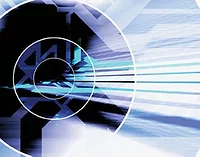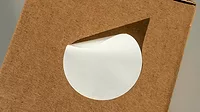Improved Performance with Radiation-Curable Polyesters
Coatings formulated with polyesters can bridge the gap in cost without sacrificing critical end-use properties. In fact, they offer an added benefit of better ease of handling, as most polyesters are lower in viscosity than either a urethane or an epoxy. Recently, new radiation-curable polyesters exhibiting superior abrasion resistance properties have been developed. One, in fact, is low enough in viscosity to make it suitable for spray or vacuum coating application.
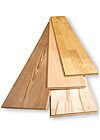
Coatings based on polyesters are increasingly chosen when high performance and sound economics are important, as they are with most ultraviolet (UV)/electron beam (EB) industrial applications. While aliphatic urethane-based coatings offer a greater degree of yellowing resistance in most cases, their higher cost may be prohibitive or unwarranted if the end product will not be exposed to harsh outdoor exposure. Epoxy-based coatings, while lower in cost, may not provide the durability and quality of performance needed for many applications. Coatings formulated with polyesters can bridge the gap in cost without sacrificing critical end-use properties. In fact, they offer an added benefit of better ease of handling, as most polyesters are lower in viscosity than either a urethane or an epoxy.
Recently, new radiation-curable polyesters exhibiting superior abrasion resistance properties have been developed. One, in fact, is low enough in viscosity to make it suitable for spray or vacuum coating application.
A “master batch” was made for each coating tested. Each formulation was applied to a chromate-treated aluminum test panel using a number 40 wire-wound rod to yield a film thickness of 4.0 mils. The coated panel was then cured at a line speed of 50 fpm on a standard conveyor system equipped with two 300 w/in medium-pressure mercury vapor lamps. These conditions were selected because they are commonly used to cure sealers and topcoats on wood. The measured integrated energy was 250 mJ/cm2 using an Illuminations Industry IL390 radiometer. All panels were prepared in this fashion and conditioned for 24 hours in a controlled temperature and humidity area before testing. These conditions were used for all scratch and abrasion testing unless otherwise specified. Additional experiments were performed on the neat, uncured coatings.
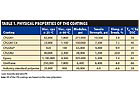
The glass transition temperature (Tg) was determined using differential scanning calorimetry (DSC), with temperatures ramped from -100 to 250°C at a rate of 20°C per minute. The Tg is defined as the thermal point at which the polymer changes from a glassy state to a rubbery state. Although not the complete answer, the Tg can sometimes be used to relate hardness. The higher the Tg, the harder the polymer.
For a more complete understanding of film strength properties, a tensile pull test was also conducted. This test was done by stretching one-half inch wide by four-inch long strips of the polymer on an Instron, Model 5543. The film thickness of each strip was approximately 5.0 mil. Tensile strength at break and Young’s modulus were measured, as well as flexibility quantified by the maximum percent of elongation at break. Twenty samples of each coating were tested to ensure accurate results. The results of these tests are shown in Table 1.
As indicated by the tensile and modulus properties, the epoxy- and urethane-based coatings were the strongest and hardest. They also had the highest glass transition temperatures of the coatings tested. However, subsequent abrasion testing has shown that it is important for the coatings to have a balance of toughness and flexibility for the cured film to have the required resiliency to exhibit the desired abrasion resistant properties.
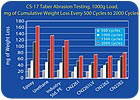
Each vertical bar on the graph represents the cumulative weight loss every 500 cycles to 2000 cycles for a given coating. The greater the weight loss, the poorer the abrasion resistance. When comparing the abrasion resistance of the three coating types, the urethane is better than the epoxy, and the polyester outperforms the urethane. All of the new polyesters are far better than the material identified as the “industry standard.”

Two formulated blends were made. In one case the polyester was blended with an epoxy, and in another example the polyester was added to a urethane-based composition. The formulated blends (1 and 2), along with the formulations containing only an epoxy, urethane or polyester, were applied and cured. Again CS-17 Taber testing was conducted using the method described in the previous section. Weight loss for each sample was measured every 500 cycles, and the cumulative results were calculated. The results are reported in Figure 2.
When the data are examined, the poor performance results are replicated for the epoxy system. An improvement is demonstrated when the epoxy and polyester are tested in a blend. Based on weight loss measurements, the overall wear properties are improved by about 27% without significantly increasing the cost.
The results are even more impressive when the polyester is added to the urethane-based formulation. The total cost of the formulation can be reduced, while the abrasion-resistant properties are improved by about 27%.

Another important point influencing the appearance of the coating is the preparation of the wood prior to coating application. Generally, wood is sanded before coating to impart a smooth finished texture. The sanding process can also influence adhesion. The finer the sandpaper, the smoother the surface and the more difficult the adhesion becomes.
Grades of sandpaper used in the study ranged from 60 (very coarse) to 1500 (extremely fine). Before coating, the surface of the maple was sanded using the different grades of sandpaper. Approximately 1.0 mil of coating was applied and then cured using two 300 watt/in. medium-pressure mercury lamps at a line speed of 50 fpm. The adhesion was evaluated using cross-hatch adhesion (ASTM D 3359) as a function of coating type and grade of sandpaper used.
The results of the adhesion testing are related in Figure 3. When the different coating types are compared, the urethane adheres better than the epoxy, with the polyester having the best overall adhesion properties. With both the urethane and epoxy, as long as the surface of the wood is very coarse, adhesion is good. However, as the surface becomes smoother, adhesion loss is noted until the adhesion is very poor. The polyester adhesion is quite good regardless of the surface condition. CN2261LV typifies the adhesion performance of all of the new polyesters tested.
When comparing the polyesters to epoxies, the viscosity is significantly lower, allowing for greater formulation latitude, improved yellowing resistance and better flexibility. Being moderately priced, these polyesters can be added to an epoxy-based system to improve the performance properties without severely impacting cost.
Compared to urethanes, the new polyesters equal, or somewhat improve, abrasion and adhesion properties. They can be used in situations where weathering resistance is not essential to the final application, while lowering the cost of the final coating.
Benefits specific to this family of polyesters include:
Editor’s note: This article is based on a paper presented at RadTech’s biennial e|5: UV & EB Technology Expo & Conference, April 2006, Chicago, IL. A version of the paper also appeared in the October 2006 issue of Paint & Coatings Industry magazine (www.pcimag.com).
For more information about the new polyesters, visit www.sartomer.com.

Coatings based on polyesters are increasingly chosen when high performance and sound economics are important, as they are with most ultraviolet (UV)/electron beam (EB) industrial applications. While aliphatic urethane-based coatings offer a greater degree of yellowing resistance in most cases, their higher cost may be prohibitive or unwarranted if the end product will not be exposed to harsh outdoor exposure. Epoxy-based coatings, while lower in cost, may not provide the durability and quality of performance needed for many applications. Coatings formulated with polyesters can bridge the gap in cost without sacrificing critical end-use properties. In fact, they offer an added benefit of better ease of handling, as most polyesters are lower in viscosity than either a urethane or an epoxy.
Recently, new radiation-curable polyesters exhibiting superior abrasion resistance properties have been developed. One, in fact, is low enough in viscosity to make it suitable for spray or vacuum coating application.
Testing the Coatings
The new polyesters were tested to evaluate their performance. For comparison purposes, a polyester considered by many to be the “industry standard” for wood coating applications also was added to the study, along with two other basic materials (an epoxy and a urethane).A “master batch” was made for each coating tested. Each formulation was applied to a chromate-treated aluminum test panel using a number 40 wire-wound rod to yield a film thickness of 4.0 mils. The coated panel was then cured at a line speed of 50 fpm on a standard conveyor system equipped with two 300 w/in medium-pressure mercury vapor lamps. These conditions were selected because they are commonly used to cure sealers and topcoats on wood. The measured integrated energy was 250 mJ/cm2 using an Illuminations Industry IL390 radiometer. All panels were prepared in this fashion and conditioned for 24 hours in a controlled temperature and humidity area before testing. These conditions were used for all scratch and abrasion testing unless otherwise specified. Additional experiments were performed on the neat, uncured coatings.

Table 1
Evaluating the Physical Properties
The viscosity of the “neat” coatings was measured using a Brookfield RTV viscometer at 25 and 60°C. The spindle used was different for each coating because the viscosities varied. The appropriate spindle was selected to maintain a mid-range reading on the dial indicator. It is worthy to note that the coating based on the new polyester had a viscosity of 420 centipoise (cps) at room temperature without the addition of monomers. This property makes the coating useful for spray or vacuum coating applications.The glass transition temperature (Tg) was determined using differential scanning calorimetry (DSC), with temperatures ramped from -100 to 250°C at a rate of 20°C per minute. The Tg is defined as the thermal point at which the polymer changes from a glassy state to a rubbery state. Although not the complete answer, the Tg can sometimes be used to relate hardness. The higher the Tg, the harder the polymer.
For a more complete understanding of film strength properties, a tensile pull test was also conducted. This test was done by stretching one-half inch wide by four-inch long strips of the polymer on an Instron, Model 5543. The film thickness of each strip was approximately 5.0 mil. Tensile strength at break and Young’s modulus were measured, as well as flexibility quantified by the maximum percent of elongation at break. Twenty samples of each coating were tested to ensure accurate results. The results of these tests are shown in Table 1.
As indicated by the tensile and modulus properties, the epoxy- and urethane-based coatings were the strongest and hardest. They also had the highest glass transition temperatures of the coatings tested. However, subsequent abrasion testing has shown that it is important for the coatings to have a balance of toughness and flexibility for the cured film to have the required resiliency to exhibit the desired abrasion resistant properties.

Figure 1. Abrasion resistance results.
Reviewing the Results
The bulk of the testing conducted in this study concentrated on abrasion resistant properties. Using a Taber Abrader, weight loss testing of the cured coating was performed every 500 cycles through 2000 cycles with CS-17 abrasive wheels, with 1000 grams total weight. The formulations were applied on chromate-pretreated aluminum panels and were cured using two 300 watt/in. medium-pressure mercury vapor lamps using one pass at 50 fpm. The panels were then cut into a size appropriate for the Taber machine. By weighing the panels before beginning, and after every 500 cycles, the weight loss due to abrasion can be calculated. The test panels were cleaned with a cloth before being weighed each time to ensure that all foreign matter was removed. Three panels were tested for each formulation, and the average of the panels is reported as the final result in Figure 1.Each vertical bar on the graph represents the cumulative weight loss every 500 cycles to 2000 cycles for a given coating. The greater the weight loss, the poorer the abrasion resistance. When comparing the abrasion resistance of the three coating types, the urethane is better than the epoxy, and the polyester outperforms the urethane. All of the new polyesters are far better than the material identified as the “industry standard.”

Figure 2. Abrasion testing of the blends.
Evaluating the Performance of Blends
When examining the three coating families from a cost/performance standpoint, coatings based on epoxies, although low in cost, may become too brittle and will yellow with time. Coatings based on urethanes are typically used when optimum performance is essential to the final application. These coatings exhibit superior yellowing resistance and enhanced scratch and abrasion properties, especially when compared to an epoxy. However, they are quite a bit more expensive and therefore increase the cost of the coating. Coatings based on polyesters tend to fall in the middle of these two cost extremes. Polyesters can be added to an epoxy-based formulation to improve the performance without having a significant impact on cost, or they can be blended with a urethane-based formulation to reduce cost while maintaining physical properties, such as scratch and abrasion resistance.Two formulated blends were made. In one case the polyester was blended with an epoxy, and in another example the polyester was added to a urethane-based composition. The formulated blends (1 and 2), along with the formulations containing only an epoxy, urethane or polyester, were applied and cured. Again CS-17 Taber testing was conducted using the method described in the previous section. Weight loss for each sample was measured every 500 cycles, and the cumulative results were calculated. The results are reported in Figure 2.
When the data are examined, the poor performance results are replicated for the epoxy system. An improvement is demonstrated when the epoxy and polyester are tested in a blend. Based on weight loss measurements, the overall wear properties are improved by about 27% without significantly increasing the cost.
The results are even more impressive when the polyester is added to the urethane-based formulation. The total cost of the formulation can be reduced, while the abrasion-resistant properties are improved by about 27%.

Figure 3. Adhesion testing results.
Testing Adhesion Characteristics on Maple
Adhesion of the coating to the substrate is another important criterion. If the coating will not adhere, then abrasion resistance is of little importance. One of the major market segments for these coatings is wood products, including flooring, cabinets and furniture. Adhesion relates to the hardness, density and cell structure of the wood. Generally speaking, the higher the density of the wood, the more difficult the adhesion. Balsa wood is quite soft with a large cellulose structure. Thus, the density is relatively low at 170 kg/m3, making the adhesion very easy. Pine is somewhat higher in density, ranging between 360-560 kg/m3 depending on the type of pine. But it is still relatively soft and porous, so good adhesion can still be realized without much difficulty. Maple, in contrast, is one of the hardest woods available and has a very small cell structure. Typical densities range to 755 kg/m3, making it almost 4.5 times denser than balsa and 1.5 to 2 times harder than pine, depending on the grade. Due to the adhesion challenge, maple was selected as the substrate for adhesion testing in this study.Another important point influencing the appearance of the coating is the preparation of the wood prior to coating application. Generally, wood is sanded before coating to impart a smooth finished texture. The sanding process can also influence adhesion. The finer the sandpaper, the smoother the surface and the more difficult the adhesion becomes.
Grades of sandpaper used in the study ranged from 60 (very coarse) to 1500 (extremely fine). Before coating, the surface of the maple was sanded using the different grades of sandpaper. Approximately 1.0 mil of coating was applied and then cured using two 300 watt/in. medium-pressure mercury lamps at a line speed of 50 fpm. The adhesion was evaluated using cross-hatch adhesion (ASTM D 3359) as a function of coating type and grade of sandpaper used.
The results of the adhesion testing are related in Figure 3. When the different coating types are compared, the urethane adheres better than the epoxy, with the polyester having the best overall adhesion properties. With both the urethane and epoxy, as long as the surface of the wood is very coarse, adhesion is good. However, as the surface becomes smoother, adhesion loss is noted until the adhesion is very poor. The polyester adhesion is quite good regardless of the surface condition. CN2261LV typifies the adhesion performance of all of the new polyesters tested.
Improving Performance and Cost
The main advantage of these new polyesters is their abrasion resistance and adhesion characteristics. This aspect is apparent in all of the new polyesters, which outperform the “industry-standard polyester” in every case.When comparing the polyesters to epoxies, the viscosity is significantly lower, allowing for greater formulation latitude, improved yellowing resistance and better flexibility. Being moderately priced, these polyesters can be added to an epoxy-based system to improve the performance properties without severely impacting cost.
Compared to urethanes, the new polyesters equal, or somewhat improve, abrasion and adhesion properties. They can be used in situations where weathering resistance is not essential to the final application, while lowering the cost of the final coating.
Benefits specific to this family of polyesters include:
- Excellent adhesion to a wide range of substrates.
- High refractive index, resulting in high gloss.
- Low APHA color, minimizing color change when used over inks or pigmented basecoats.
- A wide viscosity range available, enabling the viscosity of the coating to be tailored for a given application.
Editor’s note: This article is based on a paper presented at RadTech’s biennial e|5: UV & EB Technology Expo & Conference, April 2006, Chicago, IL. A version of the paper also appeared in the October 2006 issue of Paint & Coatings Industry magazine (www.pcimag.com).
For more information about the new polyesters, visit www.sartomer.com.
Looking for a reprint of this article?
From high-res PDFs to custom plaques, order your copy today!




